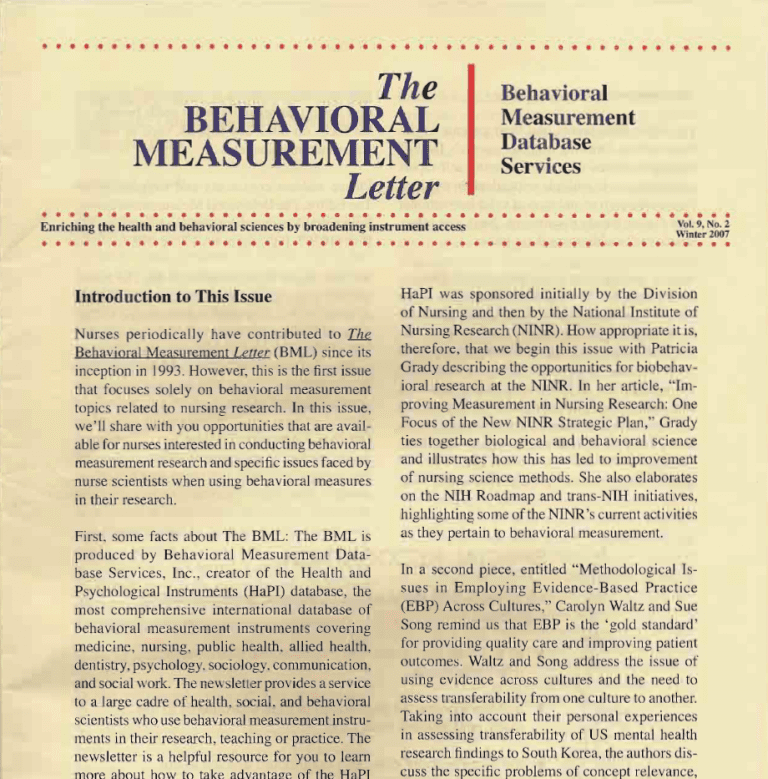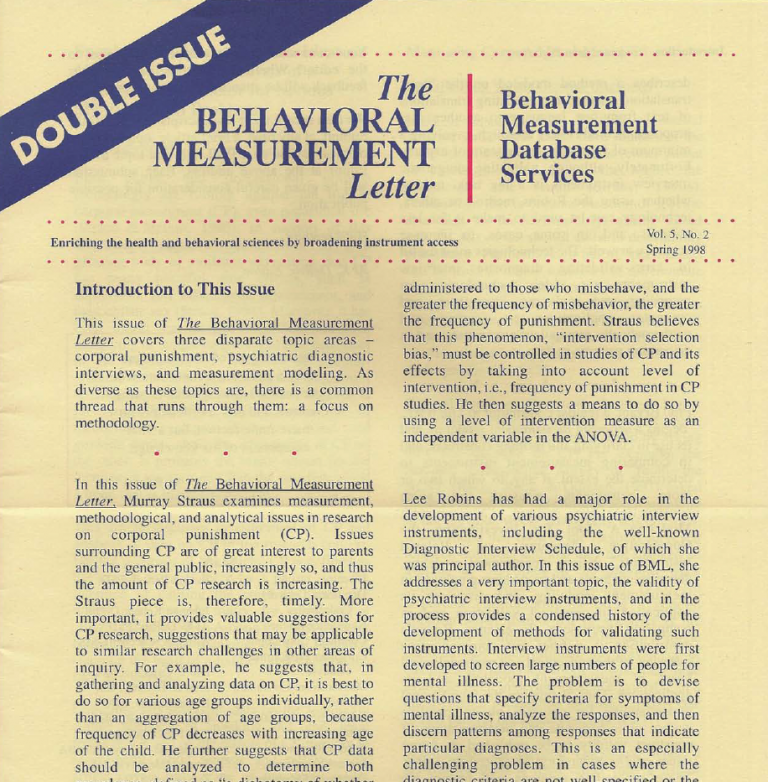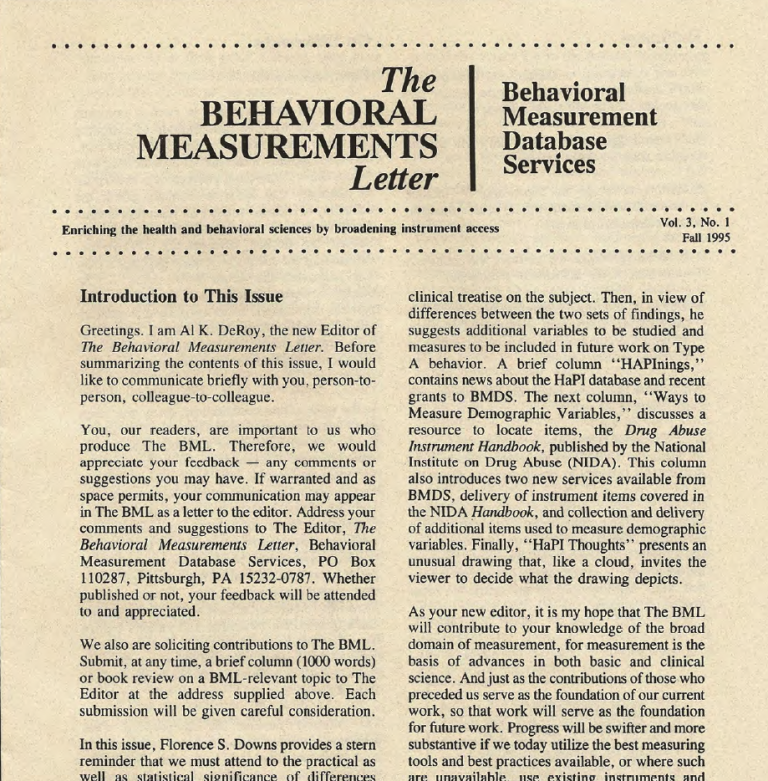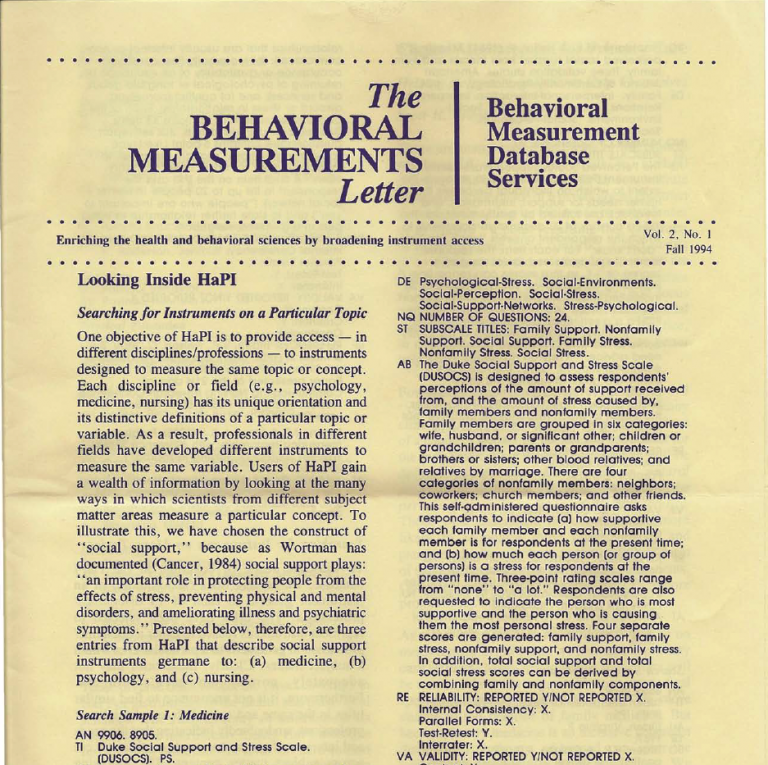Continued article from the The Behavioral Measurement Letter, Vol. 2, No. 2 Spring 1995
Marigold A. Edwards
This is my dilemma: I want to measure “relaxation on demand” or voluntary relaxation in normal, healthy people. My students report they cannot relax well in practice when any number of typical conditions (for students) exist such as being too tired, too excited, too “bummed,” a bad day, a paper due, an approaching exam, and so on. If you can relax only when conditions are “right,” then maybe you don’t really have the skill – and if you don’t own the skill, then you are denied its potential benefits.
There is general agreement and a strong body of support that relaxation is good for health and well being. And from personal experience I can attest that appropriate relaxation, being relaxed in the right places at the right time, is good for performance, too.
So, how do we measure achieved relaxation? For Edmund Jacobson, who developed the principles and techniques of Neuromuscular Relaxation or Progressive Relaxation, it was easy because he defined relaxation physiologically as the absence of tension, and tension is reflected in EMG (electromyograph) records. I recall his insistence that he couldn’t teach a person to relax; he could only teach a person to discriminate between the sensation of tension or muscular effort and its absence, relaxation. The person has to cease the effort, i.e., stop the tension. This is a tidy, elegant approach because the definition identifies the yardstick to be used, i.e., the operationa1 definition is inherent in the definition. Thus, my measurement issue stems from the lack of consensus on the definition of relaxation. Definitions abound. They range from popular perception, as when taking a vacation, “goofing off,” or otherwise engaging in pleasurable, typically non-work or distracting activities, to clinical definitions that focus on restoring chronically disrupted homeostatic pathways, and definitions employed in experimental research.
While lacking the tidy link provided by the Jacobson definition, there are approaches to assessing achieved relaxation that vary with individuals, settings, assessors, psychometric instruments, and hardware. The usefulness of the results likewise vary with these factors. For example, I found no correspondence between ratings of perceived relaxation (on a Likert-type scale ranging from “very, very relaxed” to “very, very tense”) and physiologic measures with naïve individuals. However, those who have developed mind-body awareness through movement training, even without formal relaxation training, rate bodily tension/relaxation more accurately. Jacobson preferred to work with athletes for this very reason. Moreover, some individuals rise to the demand characteristics of the situation with more favorable ratings of relaxation. Unfortunately, many relaxation studies have used such self-report instruments as the pre post measure to demonstrate having learned to relax. This is not to say that self-report cannot be useful. Jacobson’s patients were as highly trained in self-observation as champion athletes, having gone through thorough neuromuscular retraining with 3-4 sessions per week and daily self-practice of 1, 2, or more hours with record keeping for a period, for some of 1-2 years. You bet they learned to self-report accurately!
A Jacobsonian assessment approach that depends on observer experience has the individual relax while characteristics are noted such as·: forehead appears ironed out; eyes quiet, teeth apart; face expressionless; lies/sits still without holding; demeanor is peaceful, effortless, quiet. A manual test of the limbs and head looks for heaviness without resistance to easy joint movements and muscle softness. This manual test is helpful in training individuals not to react to being touched/ tested and to sense what holding versus “letting go” means in a practical way. With similar intent, though more formal, the Behavioral Relaxation Scale, developed by Poppen, lists 10 bodily “symptoms” describing the relaxed state that are monitored each minute for a 5-10 minute period by a knowing observer. However, without observer sophistication and the ability to provide feedback and coaching, observer report may be little better than subject self-report.
The stress response is defined essentially by the sympathetic nervous system (and several endocrine axes); the relaxation response likewise, by sympathetic dampening and relative parasympathetic nervous system dominance. Unfortunately, the relevant variables are not equally accessible for monitoring nor do they all move in the desired direction within or among individuals. For bread and butter relaxation training, Elmer and Alyce Green, long associated with the Menninger group, define true relaxation as “quiet thoughts, quiet emotions, and a quiet body.” The quiet emotions, as a result of quiet thoughts, are reflected in skin temperature of the hands and feet (peripheral vasodilation moving in the direction opposite to stress vasoconstriction) and skin conductance (as warm, dry hands pass little current) for autonomic relaxation; a quiet body or somatic relaxation is recorded by EMG (electromyograph). This is again straightforward, but at what point is relaxation achieved? Is it simply relative? A change in the desired direction is necessary but is it sufficient? I think not. But how much is enough?
For example, research shows that breathing with increased use of the diaphragm and decreased use of chest muscles has immediate physiologic benefits. Students in my class have resting respiration rates of 18-20 bpm typical of American adult rapid, shallow breath patterns. We know that minimal training in breathing techniques can reduce rates to < 10 bpm, even < 6 bpm. We know that Yogis can breathe comfortably at 2-3 bpm but is this better for health and well-being than 6 or 9 bpm? What is appropriate? Are there standards? Several authors have suggested criterion levels to indicate that the skill of relaxation has been successfully learned, demonstrating physiologic mastery. Presumably, me skill is then part of one’s behavioral repertoire for use on demand. The route to physiologic mastery is basic relaxation training with practice/ homework enhanced by biofeedback training which can be thought of as training wheels to speed up the learning of this psychophysiologic self-regulation. Criteria in the literature pertaining to relaxation address 3 basic response systems (in case all individuals are not neuromuscular responders, for example) and suggest forehead and forearm EMG (electromyograph) < 2.5 microvolts peak to peak; EDR (electrodermal response) < 2 micrornhos; hand temp > 95°F, foot temp > 92 °F. In addition to measuring performance, instrument readings provide validation of the subjective experience of relaxation as well as evidence of learning over time.
What is the role here of psychometric instruments that comprise the HaPI database? I have routinely used Spielberger’s State Anxiety Inventory (SAI) and subscales of McNair and Lorr’s Profile of Mood States (POMS) to measure changes in arousal following an intervention or to get a baseline, and Spielberger’s Trait Anxiety Inventory (TAI) to better interpret the scores. If the parameter of interest is low arousal, then it is reasonable to expect the psychological and physiologic measures to fit, i.e., correlate. Research, however, shows a frustrating lack of congruence between the soft (self-report) data on the one hand and the hard (physiologic) data on the other. Is subjective reality of lesser value than objective reality? Sport coaches have reported that self-report data is more useful than physiologic data and it is certainly easier to get. But consider this: I feel fine but the cuff is registering my blood pressure as 160/95 mmHg. I can’t feel it so does that mean it is not a problem? Of course not. On the questionnaire a subject checks ”I feel relaxed,” and “I feel calm,” but her forehead EMG (electromyograph) is at 5 microvolts, EDR (electrodermal response) is 11 micromhos, and finger temperature, 81°F. ‘Tis a puzzlement!
I have the J & J 1-330 software and J & J interfaced hardware to measure 8 physiologic variables: 2-site EMG (electromyograph), skin temp, EDR (electrodermal response), respiration rate, SBP (systolic blood pressure), DBP (diastolic blood pressure), & PR (pulse rate). I would like to develop a normative data bank of psychophysiologic relaxation profiles of normal healthy individuals, students, staff, faculty, and others. If the capacity to relax can be retained and cultivated rather than retrained at a later point in life when beset with psychosomatic ‘5ymptoms/ complaints, if skills now rather than pills later is feasible, then here is a health-promoting venture in the true spirit of prevention. But what is my best combination of psychometric and psychophysiologic instruments? How much relaxation is enough to achieve its benefits? At what point can one say I can do it; I own the skill; I can relax on demand?
Marigold A. Edwards, PhD. CHES, a New Zealander, is Associate Professor at the University of Pittsburgh. Certified in Biofeedback and Stress Management Education, she teaches and lectures in the various areas of lifestyle and health. That she is nationally ranked in the top 10, Women’s A squash singles 1967-1992, and national senior singles champion, 1974-1993, makes for perfect integration of the personal and professional life of Marigold Edwards.
Read additional articles from this newsletter:
In Front of the Bell Curve: A Prologue
2-2-spring-1995






















